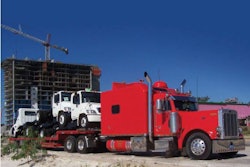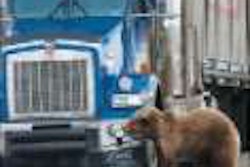Truck makers share thoughts on top issues
What is the biggest challenge facing the trucking industry over the next five years?
 Martin Daum, president and CEO, Daimler Trucks North America
Martin Daum, president and CEO, Daimler Trucks North AmericaOur industry must reduce the Co2 footprint at a price our customer can afford. The additional cost must be lower than what our customer will experience once they realize their fuel savings. We must also find the least harmful way to reduce Co2 for our customers. — Martin Daum
Trucks are getting more expensive as a result of emission standards. We continue to work on providing our customers the lowest cost of ownership to keep them competitive. — Bill Kozak
There must be sustained profitability throughout the supply chain to fund the huge investments made to meet new emissions and other regulations. Society has benefited greatly from these changes, but our industry has been denied fair recovery of its costs due to the accelerated cycle of regulatory change.– Kevin Flaherty
 Bill Kozak, general manager, Kenworth Truck Company
Bill Kozak, general manager, Kenworth Truck CompanyFleets are continually trying to improve their operating cost per mile. A vehicle’s fluid consumption – diesel fuel as well as diesel exhaust fluid – and the significant fluctuations in the prices of these fluids, are among the biggest drivers of fleets’ operating costs. A vehicle’s “fluid economy” is driving customers to demand more efficient vehicles.– Jack Allen

We see three primary challenges: Increasing legislation and regulations, the expanded use of technology and telematics to control vehicle performance, and our ability to respond to rising fuel prices with improved fuel efficiency.– Bill Jackson
Customers’ ability to absorb and implement new technologies – emissions, electronic onboard recorders, alternative fuels and hybrids – is an ongoing challenge. Trucking companies must attract or develop the necessary competence to implement and manage these technologies. — Ron Huibers
How are distribution patterns and supply chain trends affecting your products and customers’ spec’ing choices?
 Kevin Flaherty, senior vice president, sales and marketing, Mack Trucks
Kevin Flaherty, senior vice president, sales and marketing, Mack TrucksIncreased regional and intermodal hauling is driving specs toward day cabs with smaller displacement engines. Equipment acquisition costs for heavy- and medium-duty trucks have also risen faster (due to EPA requirements) than freight revenues, forcing fleets to reduce acquisition costs and improve productivity by reducing sleeper or engine sizes while increasing payload capacity.– Martin Daum
We continue to work very closely with our suppliers to provide the best value and performance to our mutual customers. Communication is key in today’s environment.– Bill Kozak
Our customers and their customers – shippers and receivers – continue to refine and innovate with packaging to deliver more product in fewer trucks. This may contribute to a new look at truck size and weight regulations. Changes in shipping routes, such as more hub and spoke operations, could also contribute to this.– Kevin Flaherty
 Jack Allen,president, Navistar North American Truck Group
Jack Allen,president, Navistar North American Truck GroupCustomers are increasingly weight-conscious. More productive loads and optimized routes will mean more money in their pocket. They are looking for trucks and engines that have similar power and capabilities but that are lower weight. Fuel prices are also reshaping the industry, fueling growth in intermodal transportation. A shift to shorter, regional routes is prompting growth in Class 8 day cabs.– Jack Allen
Peterbilt was among the first to utilize Six Sigma, rapid prototyping, and sophisticated design and logistics tools in product design. These have enabled our Model 384 to win the ATD Truck of the Year in 2010, and earn the 2009 J.D. Power and Associates Medium Duty Truck.– Bill Jackson
Many factors influence the evolution of trucks, including the need to maximize payload and minimize cost per mile, societal demands for safer, lower-emission vehicles, how trucks connect to their environment through communications and telematics, and changing freight demands, such as increased package density.– Ron Huibers
How far beyond engines will vertical integration of truck components go?
 Bill Jackson, general manager, Peterbilt Motors
Bill Jackson, general manager, Peterbilt MotorsIn the future, we will no longer need to own those companies that supply us with subsystems and components; rather, we will have a closer OEM development relationship with our suppliers. In the past, we worked with individually optimized modules. In the future, those independent modules will be developed together.– Martin Daum
Our focus is having a successful launch of our Paccar MX engine that is coming out this summer.–Bill Kozak
The Mack Pedigree drivetrain means a truck built with Mack axles and carriers, engine and transmission. Each component or system is engineered and built to work as a highly efficient and productive integrated system. This increases reliability, durability and performance since the overall truck has been optimized for its exact job.–Kevin Flaherty
 Ron Huibers, senior vice president, sales and marketing, Volvo Trucks North America
Ron Huibers, senior vice president, sales and marketing, Volvo Trucks North AmericaIn November, we acquired certain assets of Continental Diesel Systems, now Pure Power Technologies, to manufacture key fuel injection components for our MaxxForce diesel engines. Through Pure Power, we’ll further vertically integrate research and development, engineering and manufacturing capabilities to produce world-class diesel power systems and advanced emissions control systems.–Jack Allen
We are constantly evaluating value-added product offerings and components to support our industry-leading quality and product design. To complement our new proprietary engine we also offer a range of Cummins engines as an alternative. We enjoy strong partnerships with our suppliers.– Bill Jackson
Volvo has been vertically integrated since its founding more than 80 years ago. Technological change makes it more difficult to integrate different systems – you can’t integrate randomly. Volvo’s diesel engines and I-Shift automated manual transmission are technological “twins” and were integrated from the start for the highest level of efficiency.– Ron Huibers










